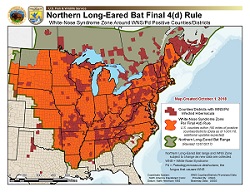Standards Highlight: Standard 5 – Fish, Wildlife, Biodiversity and Forest Health
Standards Highlight: Standard 5 – Fish, Wildlife, Biodiversity and Forest Health
 The Standards require management plans to be active and
adaptive. While many foresters focus on ensuring management recommendations
meet this requirement, remember that all the elements of the Standards need to
be reviewed routinely. Specific to Standard 5, forest health conditions change,
new T&E species are listed that might impact your landowners, and these
species can move!
The Standards require management plans to be active and
adaptive. While many foresters focus on ensuring management recommendations
meet this requirement, remember that all the elements of the Standards need to
be reviewed routinely. Specific to Standard 5, forest health conditions change,
new T&E species are listed that might impact your landowners, and these
species can move!
As an example, we reported in June 2016 on the establishment of the 4(d) Rule for the northern long-eared bat (Myotis septentrionalis) population, which has been devastated by the White Nose Syndrome (WNS) throughout the eastern United States. This disease has caused a mortality rate of up to a 90-100% where present. The U.S. Fish and Wildlife Service listed the northern long-eared bat as threatened and established the 4(d) Rule to protect the bat population during its most vulnerable life stages in areas where the disease is present known as the White-Nose Syndrome Zone. Since ATFS created two guidance documents, one for landowners and one for foresters to help with the understanding of the ruling and its implications on Tree Farmers, the WNS Zone has continued to expand and impact even more landowners.
When writing or updating a plan, be sure to include the sources that were used to determine the presence or absence of elements, such as T&E species, as well as the dates these determinations were made. This information should be reviewed on a routine basis and especially before performing forest management activities, such as a harvest, when the protection of such species is at greatest risk.


